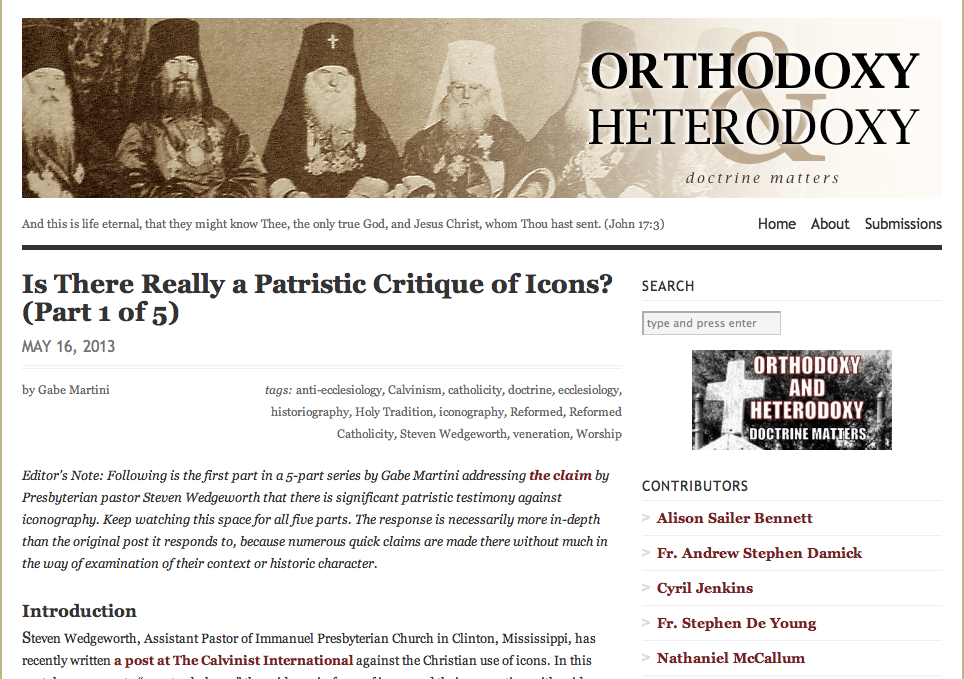Dear Folks:
On 30 April 2013, the Calvinist International posted Pastor Steven Wedgeworth’s article “The Patristic Critique of Icons.” Gabe Martini responded with a five part series on Orthodoxy & Heterodoxy.
This issue is an important one because the church fathers comprise an important part of the Orthodox Tradition. Pastor Wedgeworth challenges the Orthodox affirmation of veneration of icons with his assertion that the Reformers’ rejection of the veneration of icons was consistent with a part of the patristic witness.
This raises the question: Was there a patristic consensus concerning the use of icons in Christian worship? Was it supportive of icons or opposed? Readers are invited to read Pastor Wedgeworth’s article and Gabe Martini’s responses and decide for themselves.
Robert Arakaki

A curious question from a Anabaptist looking to find a more “pure” church, one that dates to the era of Jesus himself rather then a preacher in Switzerland haha. I am very curious why Orthodox priests, bishops etc. still wear “tiaras” or “crowns” if you will? I know the Roman Catholic church has started to do away with this, so why then does the Orthodox clergy dress “king like” (this is the best way I can describe it) if you will?
My grandparents were Amish; my father was mennonite, my mother a nazarene and I have never felt comfortable in the mennonite faith. I desire a closer connection with the church Jesus himself formed, a church that hasn’t split time and time again and really a place where I can grow closer to God.
George,
Welcome to the OrthodoxBridge! I’m not sure how to answer your question about the historic origins of the bishop crowns. Maybe someone else can answer it. As to why Orthodox clergy vestment is regal in style, I believe the answer can be found in Exodus 28. Here God instructs Moses on the making of sacred garments for Aaron that would give him dignity and honor (Exodus 28:2). The use of fine linen, gold, blue and red threads, and gemstones contrast sharply with the more austere vestments worn by many Protestant clergy. You can find out more from an earlier posting I did “Orthodox Worship Versus Contemporary Worship.”
God bless you on your journey to the Church founded by Jesus Christ!
Robert
Here’s a good website that talks about the vestments of various offices and their differences (http://www.antiochianarch.org.au/the-clergy.aspx). I would say theologically the reason a bishop wears a mitre is a symbol of authority since he is the sacramental presence of Christ(the King of Kings) in the Church. Hence the “crown”.
I found this article interesting in the light of the modern critique of icons. The author, Mark Driscoll, one of the top Reformed leaders of our time, has used the icon of John the Baptizer in correlation to the article where he explains who John is. His comments about John are interesting, making the claim that John is the proof of sovereign election. Would any one want to discuss this? But the interesting thing is, icons are used on rare occasions to show some sort of link to the early church.
http://theresurgence.com/2013/06/05/A-hero-for-young-men?utm_source=facebook&utm_medium=pastormark&utm_campaign=Pastor+Mark+Facebook
If Mark Driscoll is considered Reformed, then I am officially no longer Reformed.
Travis, that’s interesting. Thanks.
I had to chuckle at Driscoll’s last point: “John avoided adolescence.” As adolescence is a necessary stage of physical and psychological development on the way to adulthood, I’m pretty confident St. John, the Forerunner, experienced adolescence (which is also not necessarily synonymous with the abuse of alcohol and getting up to no good), though it may have been for Driscoll himself!). LOL!
Welcome George, I love this site because of the people it draws from many faith types
I always thought the Byzantine closed-top diadem was granted to the Patriarch by the Sultan after the fall of Constantinople, and the origin of the eagle rug is the same. They were two Byzantine emblems that passed to the church.
Bob,
Thanks for sharing this with us.
Robert
I forgot to add – and the double-headed eagle (former crest of the Paleologian dynasty) continued to be used by the church as well. There was no one else to use it after the fall of Serbia, the Morea and Trebizond to the Ottomans. Of course this omits the Russians who used after Zoe’s marriage – that is a separate discussion.